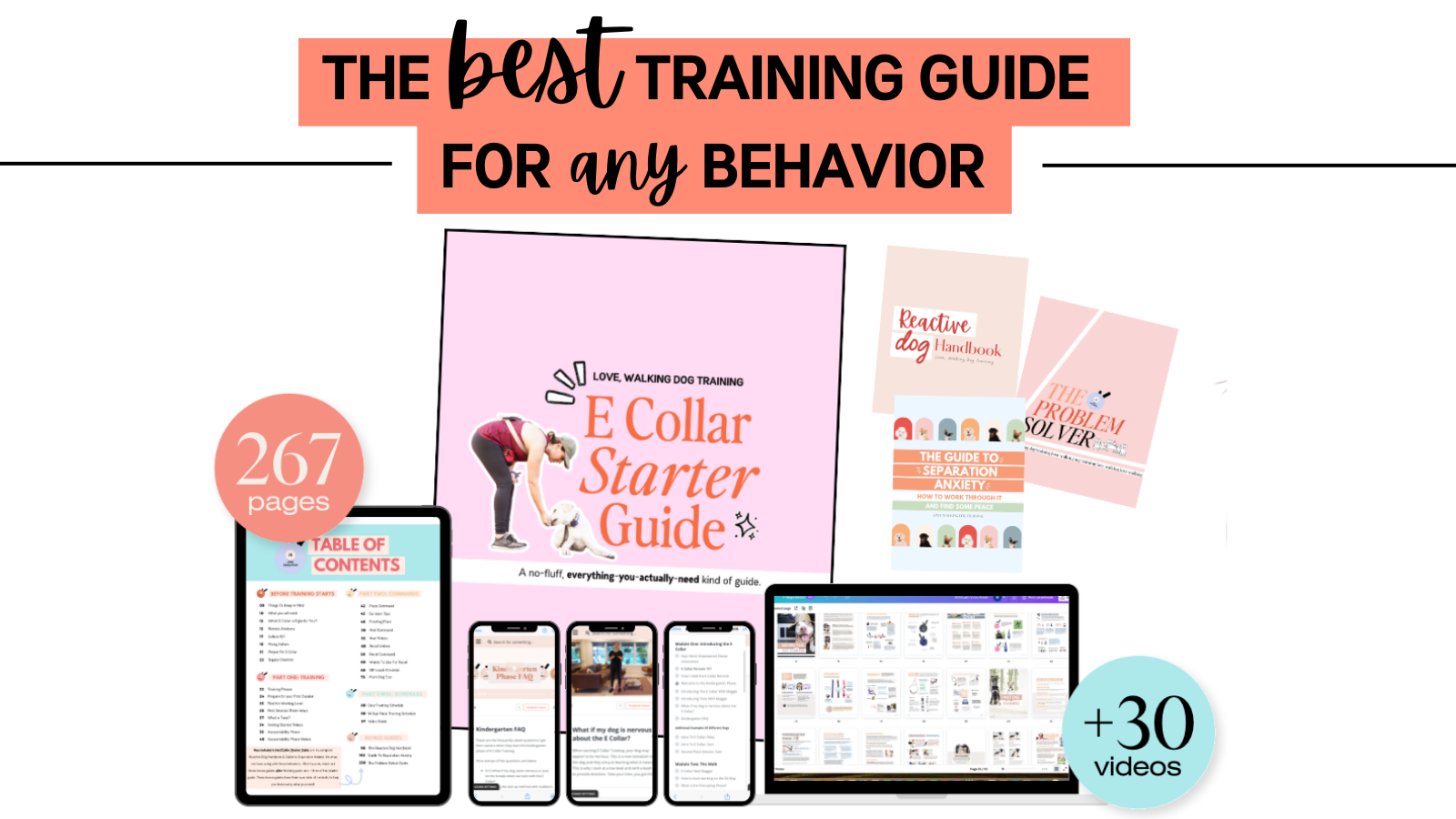Five tips for leash reactivity
About 95% of the dogs I work with are reactive. Reactivity is when a dog is visibly reacting on leash, in the home, in the car - barking, lunging, pulling, whining and overall excitement when a dog sees another dog or whatever their trigger is. Sometimes it's humans, cars or anything that moves.
Here are the things that have helped me the most when working with reactive dogs:
ONE. You're using the wrong tools. Maybe it's the "easy" walk harness or a flat buckle collar - your current tools are not helping with the reactivity. A harness is the perfect tool to encourage pulling on walks - I've never heard an owner say they wanted their dog to pull more.
I recommend switching out your tools - my favorites are the prong collar and E Collar.
Think of the E Collar as your interruptor. You know when your dog barks at something and nothing you say or do can snap them out of it? The E Collar helps you interrupt the barking and set clear boundaries in the busiest of situations.
We recommend using the Mini Educator because it has 100 levels - giving you plenty of room to find a level that means something to your dog at any moment. And if you're brand new to balanced training, read more about what it is and how it can help you here.
The first step is introducing the E Collar (get your E Collar Starter Guide here) and then you can use it to get your dog to walk nicely on leash - getting you that much closer to working through the reactivity. Take a look at the video below to see what this looks like. We also have our videos that come with the E Collar Starter Guide where you can see me work with four different dogs, hear exactly when I'm using the E Collar and watch me work through all the messy moments.
Once you've introduced the E Collar you can do SO many other things with your dog. Say no to barking out the window as dogs pass by - stop the lunging/barking on walks - and clearly communicate without getting frustrated or overwhelmed.
Once you've introduced the "language" of the E Collar, then it's time to use it to interrupt the reactivity. The Reactive Dog Handbook section of our E Collar Starter Guide shows you exactly how.
TWO. Stop with the food. When working with your reactive dog, food rewards can make things worse. Most owners end up rewarding things that make their dogs more reactive without realizing it. You think you're rewarding for walking nicely by another dog, but you're actually rewarding an excited state of mind - not helpful when trying to work through your dog’s leash reactivity.
Remember this: an excited state of mind is the breeding ground for reactivity. And the more you reward the excited mindset on a walk, the more excited your dog will get.
Bad decisions usually happen when your dog is amped up, so the more you can help your dog practice a calmer mindset (the heel command is so helpful for this - giving your dog a job on walks instead of sniffing or being extra pushy) the easier it will be for them to make better decisions.
Giving your dog a job (heel, place, down) helps them be at their best.
If you're using food on walks with your reactive dog and you feel like it's not helping things, I would encourage you to stop for the next week. Cold turkey. Stop and start to notice how your dog does. You can always reward with a calm “GOOD” to let your dog know they are doing a good job.
Using food on walks isn't bad, but all dogs are so different. Some thrive with food while others get too amped up and that's the last thing we want when working through reactivity.
I find that a lot of owners feel guilty when the food isn't working - like it's their fault. That's why I want to point out that it's not YOU - your dog is just the kind of dog that gets more excited when food is around.
THREE. Your dog is practicing excitement more than calmness. This might look like your dog has a lot of freedom in your home and can walk around doing whatever they want = E > C (excitement more than calm). If your dog goes to doggy daycare most days = E > C. If your dog lays on the couch staring out your front window when you leave and barks at things as they pass by = E > C.
Dogs usually make bad decisions when they are living with an excited mindset. It’s ok to visit the excited stuff (fetch, backyard zooms), but living with an excited mindset is not helpful for reactivity.
This is a big reason why I like to encourage you to give your dog a job like heel on the walk. When your reactive dog doesn't have a job to focus on, it's much easier for them to get excited on walks - pulling you all over the place and barking at other dogs. When your dog has to focus on the job of heel and walk next to you, it helps them relax more - nurturing a calmer mindset. This plus utilizing the E Collar on walks - chef's kiss! Better decisions are made when your dog is calm and has clear direction, so it's essential that we help them practice it daily.
You can do this with the place command (learn how to get started with place here), heel on the walks and kennel time during the day. Look at your dog's day and ask yourself, when can I incorporate the calm stuff to help strengthen my dog’s "calm muscle?" Add it in when you can. Every little bit helps.
FOUR. You talk to your dog too much. I'm not going to tell you that you can't talk to your dog anymore, but I do want you to notice when you're talking to them. It's a lot like the saying - 'what you pet is what you get.' I like to use this one to remind you that you might be unintentionally rewarding bad behavior when loving on your dog.
Side note - please don't try to pet your dog during a reactive moment. It doesn't work. You're pretty much saying, I love what you're doing, sweetie! Keep barking! Mommy loves it.
Dogs are such physical beings. You can't talk them out of things with words unless the words actually mean something.
(ps the E Collar helps so much with this!)
Any time your dog starts barking or getting reactive on a walk, whatever you're saying just adds more noise to an already chaotic moment. With reactivity we want to deescalate the situation as much as possible. You shouting at your dog is doing the opposite. It's important to understand this, because any time I tell you to practice place or add in some calm kennel time during the day, it will be helpful to fall back on this idea and why it's so important.
This is one of the many reasons why I love using prong collars and e collars on the walk. You can let the tools do the talking and they help to deescalate your dog in those worked up moments. Something no amount of talking can do.
FIVE. You only address reactivity on walks. The majority of owners I talk with are mostly concerned with reactivity on the walk. I was just talking with an owner through a virtual coaching session and she has a reactive doberman. He's not only reactive on the walk but also in the car and in her home when there's a dog on the tv. Most of our talk was about the reactivity on walks and then she mentioned that anytime he sees a dog when they're driving, he goes nuts - lots of barking.
BINGO. Here's what this tells me - we are missing pushy moments to address that will make a big difference with reactivity on walks. Let's break it down.
When it comes to car stuff I like to give dogs a job - the down command. I asked her if her dog laid down or sat up in the car.
He lays down but constantly pops up.
I told her the first thing to work on is down in the car. This might look like sticking to the driveway and not going for a drive when first working on the down command. A lot of dogs find it tough when they hear your seatbelt come on and off. Some dogs pop up any time the car moves. Start with these small moments and work your way up to a driving around the neighborhood.
If you're ever wondering what you should work on, ask yourself - what was my dog doing before _________ (enter problem behavior). Before her dog was barking in the car, he popped up from a down. Working on solidifying the down command will be helpful.
If your dog gets reactive anytime someone walks by your house, what was your dog doing right before that? Walking around with too much freedom. Start to swap free time for place time and see how your dog does. Then you can go even further - your dog pops off of place to bark at the window. Much like the car reactivity, make some time to solidify down on place so your dog knows they can't pop off anytime.
If you are only focusing on the reactivity when on walks, you're probably missing key moments during the day when your dog is practicing reactive behavior. If you address reactivity inside, it will make a difference on your walks. It all adds up.
I hope these things are helpful! Let me know if you have any questions.





